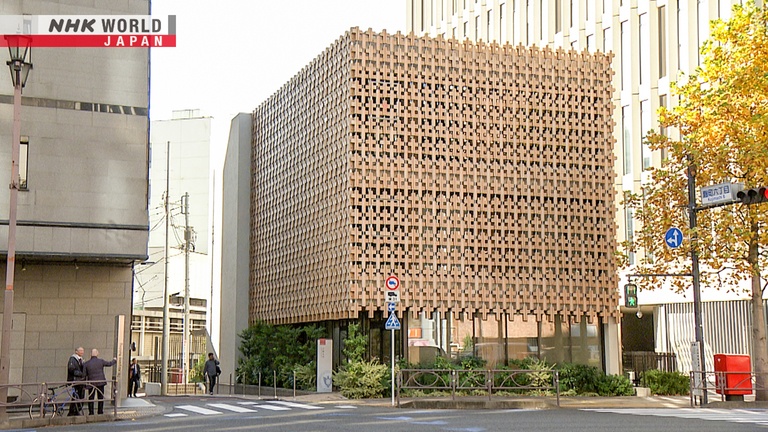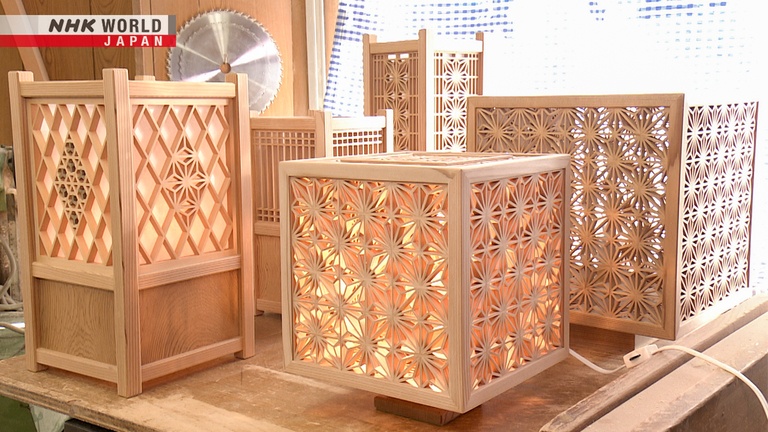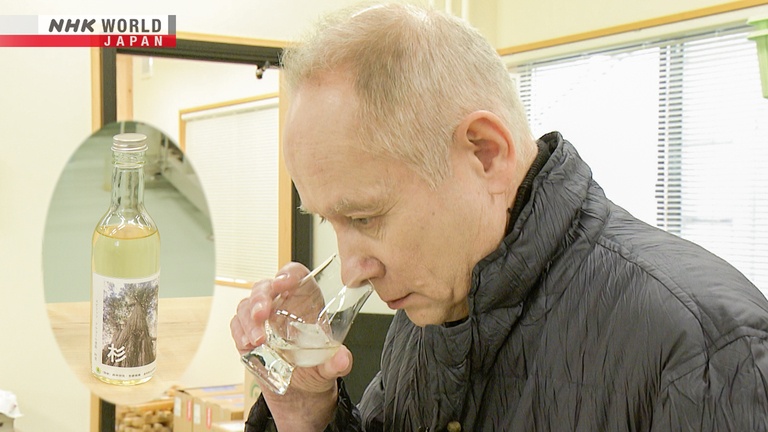Forestry
*First broadcast on January 25, 2024.
Two thirds of Japan is covered in forest, and wood has long been the building material of choice. But today, forests are in poor condition. We look at current efforts to revitalize forestry in Japan.



Transcript
Japanology Plus
Hello, and welcome to Japanology Plus.
I'm Peter Barakan.
As you may be able to hear,
I've caught a cold,
and there's nothing I can do about it.
I'm afraid you're going to
have to bear with me today.
I'm in a premium timber market,
with lots of specimens like
this magnificent one here,
which is 200 years old.
Japan is a heavily forested
and mountainous country,
so wood has always been
a common building material.
However, the forestry industry
recently has been struggling,
with its workforce down to about
a mere ten percent of what it used to be.
And when forests aren't
properly maintained,
that can lead to landslides
and things like that.
Fortunately, there is a movement
to try and do something about it,
as we will see later in the program.
Forestry
Japan is among the most
forested countries in the world—
two thirds of the land has tree cover.
A related fact: 90 percent
of houses have wooden frames.
Wood is used to make household goods
and countless other objects—
traditional and modern.
It plays a role in many
aspects of life in Japan.
Trees are also objects of worship.
Some shrines have sacred trees,
said to be home to deities.
And many temples feature Buddhist
statues made of wood.
Since ancient times, trees have played
an essential role in Japanese life.
Good morning, Hori-san.
Hello.
Nice to meet you.
Nice to meet you. Thanks for having me.
Our guest this time is Hori Yasuto.
Hori researches forestry, the timber
industry, and village revitalization.
He conducts surveys of forestry workers
and explores ways to
use natural resources.
Our first stop is a building in Tokyo.
Peter, this building is made of wood.
That's quite impressive, isn't it?
Oh, it's a university building.
Yes.
The three-story building is
part of Sophia University,
and was constructed in 2022.
Wood isn't just used on the outside;
it's a key material for pillars
and interior decoration.
I don't think I've ever seen
anything quite like this.
Normally with these large buildings
you tend to think of them as
always being concrete and glass.
Yes, yes.
But they've been popping up lately.
Oh.
Large wooden buildings like this.
The Tokyo Olympics showcased one
leading example: the National Stadium.
That's made from wood.
At least, it features the use
of a great deal of timber.
Right, right.
And that reflects a growing trend.
For some years now, the use
of wood has increased.
There are two main reasons.
First, about 40 percent of
Japanese forests are actually artificial.
Most were planted 50-60 years
ago to produce timber.
Well, those trees are finally
ready to be cut down.
So the national government has been
pushing for that wood to be used widely.
The second reason involves global warming.
Timber can in fact be used
as a countermeasure.
As trees grow, they absorb
carbon dioxide from the air.
And that ends up being
stored inside the wood.
If you then use the wood
to construct a building,
the carbon dioxide is sealed
away—within the structure.
And so, a city that's full
of wooden buildings
actually becomes a way to store
a huge volume of carbon dioxide.
That's one way to think about it.
In addition to plentiful timber
and carbon-dioxide countermeasures,
technological development
is another factor
in the increased use
of wood as a building material.
One important technology
is called CLT: cross-laminated timber.
For CLT, you first cut wooden planks.
Then you glue them together.
Previously,
you'd keep the planks parallel,
matching the direction of the grain,
to produce a large beam or pillar.
But with cross-laminated timber,
the grain of the next layer of planks
is placed at a right angle,
perpendicular to the previous layer.
That's how a block is formed.
They're strong both
horizontally and vertically.
So CLT is a very useful
construction material.
Really?
And of course with wood,
the other worry is fire, of course.
Ah, fire.
That's another problem that technological
development is helping to solve.
There's a material called
fire-resistant laminated wood.
It doesn't burn very easily.
At its core is regular wood.
That central element is what
bears the weight of the building.
But surrounding the core
is another type of wood.
That wood has been specially
treated to be flame resistant.
And it's glued onto the core.
Outside that is another
layer of regular wood.
It's a pretty bulky material.
If a fire breaks out,
then the outer layer may burn.
But the fire-resistant section
will tend not to burn.
And so the net result is that
the building will not collapse.
Japanese forestry began
in earnest in the 6th century.
Increasingly sophisticated tools made
larger wooden buildings possible,
and that pushed up the amount of logging.
Trees were felled to construct temples,
shrines, and cityscapes.
During the tumultuous 16th century,
Japanese warlords made heavy use
of timber to build awe-inspiring castles.
Until the 17th century,
cleared forests were not replanted.
People simply waited
for new trees to grow.
This approach had a devastating effect.
A once-forested landscape was
transformed into barren mountains.
Timber was in short supply,
and tree-less mountains were
a factor in severe flood damage.
Accordingly,
the Shogunate encouraged people
to plant trees and protect forests.
As a result of these
government initiatives,
forests all over Japan
were able to recover.
Then came the 20th century,
and a succession of military engagements.
Wood and charcoal were needed
for shipbuilding, construction, and fuel.
Japan's mountains were once
again stripped of their trees.
In the postwar period, timber was
urgently needed for rebuilding purposes.
So the government ordered
the planting of fast-growing conifers,
such as Japanese cedar
and hinoki cypress.
To boost supplies, the government eased
regulations on timber imports in 1964.
Because imported timber was cheaper,
demand for it was higher
than for Japanese timber.
Also, coal and oil were quickly replacing
wood in many everyday situations.
Japanese forestry went into decline.
This, in turn, led to a lack
of important maintenance,
such as the thinning of trees.
Without such care,
trees cannot fully spread their roots.
In densely packed areas,
sunlight is blocked.
Roots become weaker and trees collapse.
As forest health declines, heavy rain
increases the likelihood of a landslide.
These days, the degradation
of Japan's woodlands is a serious issue.
Our next stop is Hori's workplace:
the Forestry
and Forest Products Research Institute,
a place to study everything from
wildlife to forest restoration.
What is the current state of forestry?
Forestry jobs once had a bad reputation.
They were said to be
“difficult, dirty and dangerous.”
And as a result, very few people
chose to enter the industry.
To counter this,
the Forestry Agency introduced a policy
in 2003 called “green employment.”
It involved educating people
who were interested in forestry.
They were provided with
various training opportunities.
Also, companies were subsidized
so that they could more easily
hire young members of staff.
Those are some of the measures
that were introduced back then.
Since then,
more young people have indeed
been choosing to work in forestry.
But even with the increase in
young people getting into forestry,
there's still a real lack of manpower,
isn't there?
Yes, the labor shortage
is a serious issue.
So the industry has to get a lot smarter.
What does that entail?
Well, one aspect is the introduction
of new technology.
For example, drones can be used to
survey the condition of mountainous areas
that are difficult to traverse on foot.
And when we're planting trees,
larger drones can be used
to transport saplings.
Ohh.
I think we really need to push
ahead with that sort of thing.
These days, we have large-scale
modern industrial machines.
I'm thinking of things like
processors and harvesters.
They can remove branches
from felled trees,
and then cut the wood to produce
sections of a uniform length.
Machines like that are becoming
increasingly common.
Making use of that technology
helps to improve productivity.
And it leads to a higher level of income.
When learning how to operate
these machines and drones,
young people can treat it like
they're playing a video game.
They pick it up so quickly!
Ahh.
Much faster than old folks!
OK, yeah.
Another advantage of machinery is that
it reduces the need for physical exertion.
That allows people with less strength
or stamina to get involved in forestry.
Interesting. OK.
So introducing modern technology
has various benefits.
It improves productivity,
safety, and income.
That kind of advantage
will prove to be vital.
Hello everyone. Welcome to Plus One.
I'm Kyle Card.
The Japanese have always utilized
the timber around them
to build houses, furniture,
bowls, utensils...you name it.
And through all that tinkering,
some very unique woodworking
technologies were born.
One such technology has become
very culturally significant,
and it's called kumiko.
Let's go learn about it together.
Looks like the place.
Konnichiwa.
- Hello.
- Hello.
Is this kumiko?
It sure is.
It's beautiful. Wow.
Thank you.
In what sort of situation and what sort
of products do you use kumiko for?
Well, in a traditional Japanese house it
was used in sliding doors, for instance,
and the panels above dividing screens.
That's where you'd see it.
Kumiko is a Japanese latticework technique
with over 1,400 years of history.
Wood is cut and arranged
into complex patterns,
without nails or metal fittings.
This is super intricate, like what kind
of tools do you use to create this?
In general, nothing complicated.
First, saws.
Regular planes, like this.
And we use special planes like this
on the edge of a piece of wood.
Shall I show you?
Yes please.
Like this...
Oh, an angled cut.
Interesting.
There we are.
Ah, wow, you can make a nice
point on that. Check that out.
That's so intricate. Wow.
Today, you're going to make a coaster.
That's so cool.
It's an 8th-century hemp-leaf pattern.
It's often used on clothing
for newborn children.
It represents a wish for healthy growth,
and wards off misfortune too.
You're going to add the small bits inside.
Heh, heh.
I made all of these by hand.
OK.
We'll start by adding four pieces.
Then just put it right in here?
Yes.
In a working day, I make 70 of these.
That's quite a lot.
Very good.
Next, add glue here and here,
then insert it like this.
OK, here we go.
Is it gonna work?
Push down as you go.
All right, pushing it
down while doing it...
It takes some force.
Ahh!
Oh, it broke!
That's fine; I have another.
So, put it in.
Don't have too much strength.
Kyle battles on.
And finally, after 40 minutes,
he has just one more piece to go.
Last one.
How am I doing, sensei?
Fine! You're doing well.
You can be my apprentice if you like.
Really?
Yay!
I can become his deshi from tomorrow.
Boom. What do you think?
Very nice.
Wow, I did it!
I did kumiko.
Thank you so much for
the wonderful experience.
My pleasure.
It's truly baffling to think that
this carpentry technique has been
passed down for over 1,400 years.
It just really goes to show you that Japan
is unmistakably the country of wood.
Japanology Plus
Some studies in Japan focus
on potential new uses for wood.
Let's take a look at one or two examples.
This lab uses the lignin that
is found in Japanese cedar
to develop new composite materials.
A prototype circuit board
film has been developed.
The research is also being
applied in speaker diaphragms,
as well as in the body
of cars and aircraft.
The Japanese cedar lignin that
contributes to novel materials
comes from Japan's own forests.
It's an original
world-leading technology.
And at this facility,
research is advancing on a different
innovative topic: wooden satellites.
Ultraviolet rays and
extreme temperature differences
are among the harsh realities of space.
But the team sent wooden
materials into space,
and found that even in those conditions,
the wood didn't crack, warp, or peel.
However, the drastic temperature changes
do cause wood to expand and contract.
Using nails could end
up damaging a satellite.
The solution was a traditional
craft technique.
Somewhat like kumiko,
this technique involves assembling wood
using clever joinery, rather than nails.
Wood may seem like an outdated
material at first glance.
But it has many uses,
and I want to showcase its potential.
A wooden satellite may even be
launched before the end of 2024.
Lignin is just one of the many potential
uses for wood that we study.
Inside here, I'd like you to
see another area of research.
OK.
Thank you.
This is the head researcher.
Hello, nice to meet you.
Hello.
I'm Otsuka, in charge of research here.
So what have you got here?
This is the world's first method
for using wood as a raw material
to make alcoholic drinks safely.
You're making sake out of wood?
I mean I've heard of wine
being aged in wooden casks,
but this is something
totally different, right?
Right.
We ferment the wood itself
in order to make alcohol.
It's a brand-new type of drink.
How is that done?
Cellulose, the fibers used to make paper,
account for about half the material
in most kinds of wood.
Cellulose is related to glucose,
which is used to make alcohol.
However, even when wood is
ground into a regular powder,
the sugar inside is
impossible to extract.
So ceramic beads are used to
grind the particles right down
to a size of less than one
thousandth of a millimeter.
This technique allows the glucose
to be successfully extracted.
After food enzymes and brewing yeast
are added, fermentation begins.
The result is a form of alcohol
that is safe to drink.
Would it be OK to try something?
Certainly.
We're actually conducting
a tasting survey,
so—if you would—please try the drinks
we've made and complete the survey!
Yeah sure.
Peter's going to try
four different varieties.
The first is made using Japanese cedar.
In fact, it's not that strong a smell.
It's nowhere near as strong
as a normal spirit.
It's more like a...
not exactly like a fortified wine,
but maybe something close to that.
But the taste is something quite novel.
It's hard to put into words really.
OK.
So this one's “soft aroma”...
Next, mizunara oak.
OK.
A hint of licorice.
Peter tries all four varieties,
and his top choice is Japanese cedar.
The wood that was used to make
the drink came from a 44-year-old tree.
So this is vintage stuff?
Yes.
That's what you drank.
So 44 years' worth of forest
existence is now inside your body.
Inside your cells.
It's like you're absorbing the tree.
That's one way of looking
at drinking this tree alcohol.
Now that's...that's really
rather special, isn't it?
Arigato gozaimasu.
Amazing really that something
like that could be discovered.
If people make products out of that,
for example, and other things as well,
does that have a knock-on effect
on revitalizing forestry?
An alcoholic drink is just one example.
Wood can be used to make so many products.
But that's not the only thing we're
investigating at the moment.
For example, we're considering how
to use the forest environment itself.
“Shinrinyoku” is a term that is used
to refer to the positive effect
of spending time out in nature.
And we're trying various
other projects too.
One example is mountain biking.
Many mountains are rarely visited
and have not been maintained.
But in preparation for cycling events,
paths can be cut through the undergrowth.
That makes a trail available to
people who ride mountain bikes.
This generates a new source of
income for the owner of the land.
Of course, the landowner
is grateful for that.
Meanwhile the mountain bikers
get new locations to enjoy.
So they're happy, too.
You get a win-win outcome.
Everyone's happy.
I'm not a mountain bike rider myself,
but you mentioned shinrinyoku,
which is, I suppose literally
if you translate it into English
it's “forest bathing.”
But it's such a nice...not only
the expression but the whole idea of it,
that you walk in a forest and you just...
you breathe in the goodness of the trees.
And it is, it's a wonderful
experience, isn't it?
It is.
There are so many possibilities.
Forests give us timber, but are
also valuable in and of themselves.
You can think of so
many different benefits.
Benefits for landowners, for forestry
workers, and for visitors too.
They all stand to win from this.
Thank you very much.
My pleasure. Thank you.